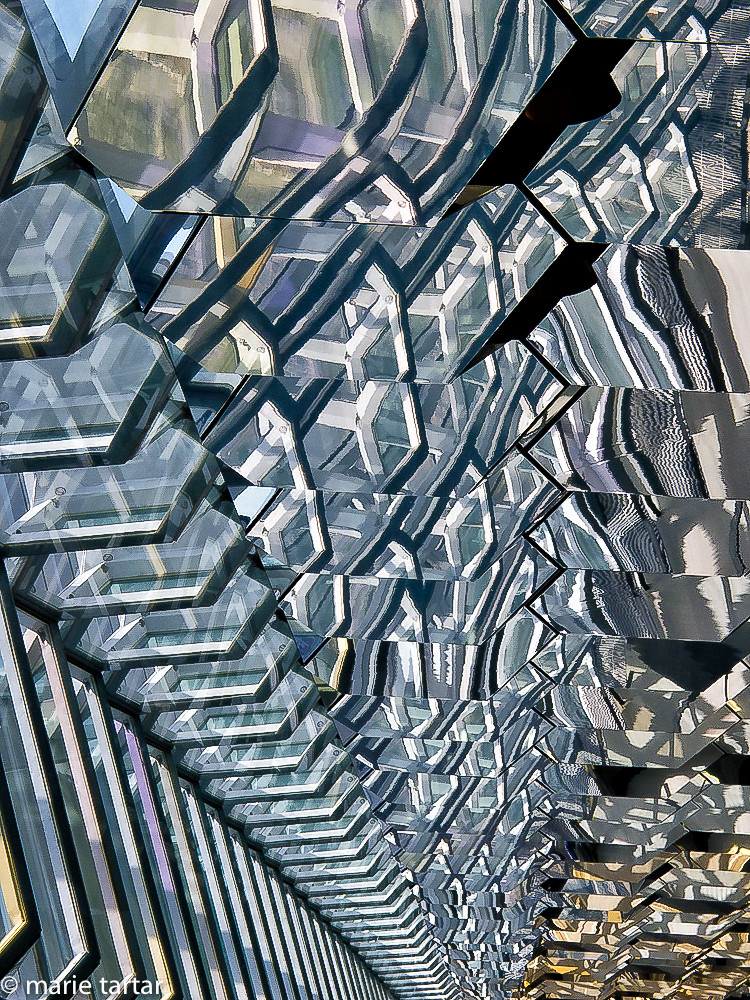
Our recent trip to Iceland, the second in 3 years, has spawned such a torrent of words, thoughts, reflections and images, that I’ve decided to break my dispatches into sections, lest the writing and image processing go on forever and never make it to the “Publish” step.
First up, literary and artistic Iceland, a managable topic, or at least a reasonable number of images to process. Iceland is a surprisingly rich cultural destination. We learned this quite by accident shortly before our first trip in 2011, thanks to Athenaeum director Erika Torre, who previously visited with InSite. A conversation with her at an opening cued us into Iceland’s possibilities as a contemporary art destination. Prior to that, we had thought of Iceland solely in terms of its geographic variety and as a landscape photography destination, imagining the possibilities of glaciers, icebergs, volcanos, lava, moss, and endless sun. It was all that, and much more.
Iceland is a nation of readers, with one of the highest literacy rates in the world. Books are the most popular gift to give for Christmas, leading to the annual Jolabokaflod “Book Flood,” with most book sales taking place from September to the end of the year. This tradition is said to stem from WW II, during which there were strict restrictions on imports, with imported paper being more available than other commodities. It begins with release of Bokatidindi, a catalog of new publications from the Iceland Publishers Association, distributed free to every Icelandic home.
In 2011, Reykjavík was designated a UNESCO City of Literature. Iceland has produced one Nobel Prize winner, for literature, Halldór Laxness.
In our travels, we had a few literary brushes, even though our trip was really given over to nature photography. Although we’ve never managed a visit to his home turned museum, Gljúfrasteinn, a highlight on both trips were overnight stays and dinners at Hotel Budir on the Snaefellsnes Peninsula, reputedly a favorite of Laxness’.
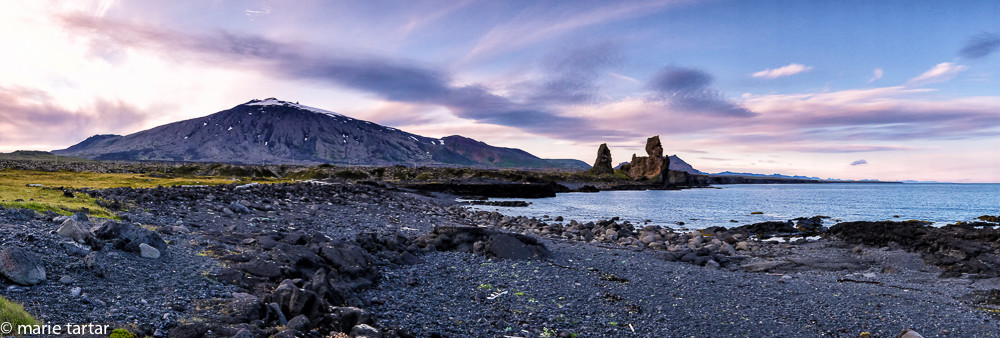
Sadly, Snaefellsjökull’s glacier cap has receeded so much it might not have inspired Jules Verne today
The volcanic crowning glory of the far west end of the Snaefellsnes Peninsula, Snaefellsjökull, finally emerged from cloud cover for us on our second trip. Frenchman Jules Vernes used the glacier topped volcano as the setting for his “Journey to the Center of the Earth.” It also plays a role in Laxness’ Under the Volcano.
Even in a tiny hamlet in southeast Iceland, our staging grounds for visiting the glacier-strewn lagoon beach Jökulsárlón, held a literary surprise, a restaurant and museum, Þórbergssetur, devoted to local son Þórbergur Þórðarson. He is memorialized by a contemporary structure resembling a bookshelf, filled with books by this author.
At the restaurant, I was told the author was so prolific that the “shelf” doesn’t hold all of his titles. Back home, I stumbled onto an interesting blog of Darien Fisher-Duke, Icelandic Fever: A Southern Saga (I loved his subtitles: An Enthusiasm for Iceland Grows to Mythic Proportions. A Virginian on the Edge of Becoming a Berserker) learning that only one of his 47 books has been translated into English, In Search of My Beloved, and that he was an influence on Laxness. I later learned that there are 5 writer’s museums in Iceland.
As for art, from Erika, we learned about Videy Island, accessed by a 5 minute ferry ride from Reykjavik. Videy Island is a historic site, combining nature, art, solitude and views. A former monastery and residence of an Icelandic governor, it now is a quiet refuge for Reykjavik city dwellers and visitors for a pastoral walk.

West end of Videy Island is studded with pairs of basalt columns, part of the Milestones installation of Richard Serra
The west end of the island is punctuated with a Richard Serra installation, Áfangar (Milestones), consisting of paired basalt columns around the periphery of the island. This choice seemed a very appropriate and symbolic one as our trip progressed, as we often saw lava formations evoking these forms on our travels around the Iceland.

An example of the naturally occurring basalt formations which were inspiration to Serra
(Svartifoss (Black Fall) in Skaftafell)
A Yoko Ono piece called Imagine World Peace consists of white marble placards inscribed with “peace” in different world languages which cover a wishing well. During the winter, light beams emanate from it, forming a virtual lighthouse. As she says, you can’t always see a lighthouse. A Reykjavik resident I spoke with told me it can be seen from miles away when lit, as it is yearly on John Lennon’s birthday. He told me that since the financial meltdown of 2008, it is now lit for 3 months in the winter, where formerly, in more flush times, it remained lit for 6 months at a stretch.
Reykajvik itself is replete with museums, many of which we still didn’t manage to see, even in 2 weeks over 2 different trips (of course, actually attending the radiology continuing education meeting interferes with other activities).
One of our favorite museums was next door to the radiology meeting we were attending.
The museum, Asmundarsafn, is one of three branches of the Reykjavik Art Museum and the former home and studio of 20th century sculptor Asmundur Sveinsonn. It is surrounded by a sculpture park, articulated by many Sveinsonn figural and abstract works. The building is interesting as well, a light filled, concrete, geometric structure which he built himself. It includes a studio, a domed exhibition space, and a semi-circular, skylit gallery space.
On our first trip, we made a pilgrimage to a mid-century modern gem, the Nordic House, south of downtown. A later work of Alvar Aalto, the Nordic House was built to foster cultural relationships among the Nordic countries, whose flags fly outside. As well as the building, he designed the furnishings and fixtures. The blue-tiled roof has a stepped configuration, echoing the contour of the mountain backdrop. 
At the time of our prior trip, Dill, the NOMA of Reykjavik, was the in house restaurant, where we enjoyed lunch so much (fish soup and great salad), that we booked for dinner for the following night. Our tour was narrated by an actor playing Aalto. Returning in 2014, Dill has moved downtown, but retains its stature as one of Reykjavik’s preeminent restaurants. Dill makes an appearance as itself in the film “Land Ho!”, which was playing at our local Landmark theater when we returned home, enabling us to immediately relive our trip.
Another artistic destination is right on the waterfront, the Harpa concert hall. The finishing touches were being put on it on our prior trip.
In addition to housing several concert venues, there is a restaurant and a street-level café, as well as several stores.
Harpa (meaning harp) is a design by Danish architectural firm Henning Larsen. Its vibrant faceted glass façade is a collaboration with contemporary artist Olafur Eliasson (raised in Denmark, son of Icelandic parents). The curtain wall is dazzling and mezmerizing, with scattered colored insets, casting a shifting light play onto the floor.
Even the signature church, Hallgrimskirja, a landmark which defines the Reykjavik skyline along with Harpa, held artistic surprises for us.
The church’s concrete pillar stepped facade is said to be another reflection of the ever present basalt columns occurring naturally throughout Iceland. For a small fee, one can ascend the tower by elevator, where the colorful Monopoly house architecture of Reykjavik is well seen.
I found the tower clocks themselves photo-worthy the first trip and on the second, found them the subjects of a colorful artistic intervention.
Beating Time, by Jo Yarrington, references work by the same name by motion studies photographer Muybridge, also of a conductor’s hands. In this case, the local tie-in is to the conduction in this church of well known hymns composed by the church’s founder, Hallgrimur Peturssón.
A 2 hour drive from Reykjavik, the Snaefellsnes Peninsula is home to another visually fascinating art installation, with reflections and distortions which are a photographer’s dream. Erika Torre had alerted us to this contemporary art installation gem, the work of American artist Roni Horn, prior to our first trip, indicating it in her notes as “Very Important”.
The Library of Water (Vatnasafn) occupies a promontory with panoramic views of the picturesque fishing village.
These views are refracted through water-filled floor-to-ceiling columns, evoking the beam-me-up Scotty transporters in Star Trek.
The 24 columns aren’t filled with any old water, but each is filled with water from one of Iceland’s glaciers. Sediment from the water imparts a golden glow at the base of each column. The floor is embellished with text, words in English and Icelandic evoking that dominating Icelandic force, the weather, and equally, states of mind (bright, sunny, breezy).
As before, I found the light play and distortions of viewers and slices of the village through the columns visually fascinating.
An artistic discovery we made on our own was the work of Ger∂ur Helgadóttir, which can be seen in a fabulous block long tile mosaic from 1973 on a building near the harbor (Tolhus or Customs House on Hafnarstræti),
as well as in the stained glass windows of churches in Kopavogur (just south of Reykjavk) and Skálholt (on the Golden Circle route), as well as in the museum formed from the work given by her heirs at Kopavogur (Kopavogur Art Museum-Gerdarsafn) . The museum is housed in a 1994 contemporary building by Benjamín Magnússon, in a suburb of Reykjavik. The nucleus of the museum is the work of this sculptress whose work we admired all over Iceland.
Gerdur’s work at the museum was represented by predominantly metal sculptures, with some sketches for mosaic murals and works on paper. She seems to have been the Bertoia of Iceland.
As I talked with the gorgeous young blonde woman at the entry desk, I learned that a small interesting looking church nearby also featured her stained glass work. It had been closed when we went by earlier and the posted hours indicated it to be open only on weekday afternoons.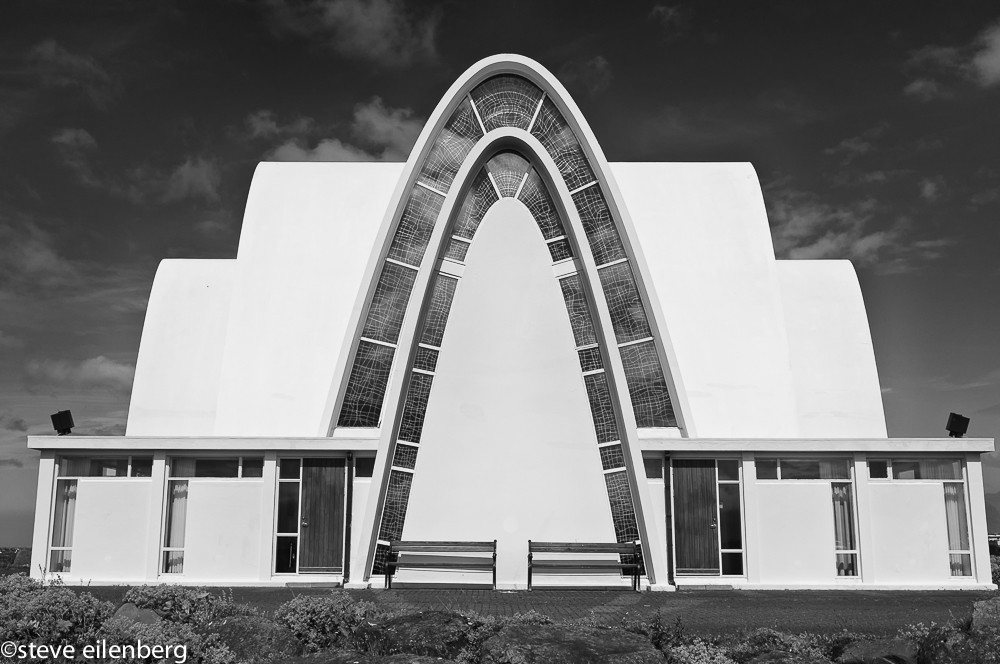 We noticed a few vehicles by it when we departed the museum and returned to find it open, thanks to preparations being made for a wedding later that day. We were lucky in our timing, as the wedding preparations were not so far along that the few people on hand minded us slipping into the church for a few minutes.
We noticed a few vehicles by it when we departed the museum and returned to find it open, thanks to preparations being made for a wedding later that day. We were lucky in our timing, as the wedding preparations were not so far along that the few people on hand minded us slipping into the church for a few minutes.
It was another little gem, with steeply arched sides framed by the abstract, luminous glass. 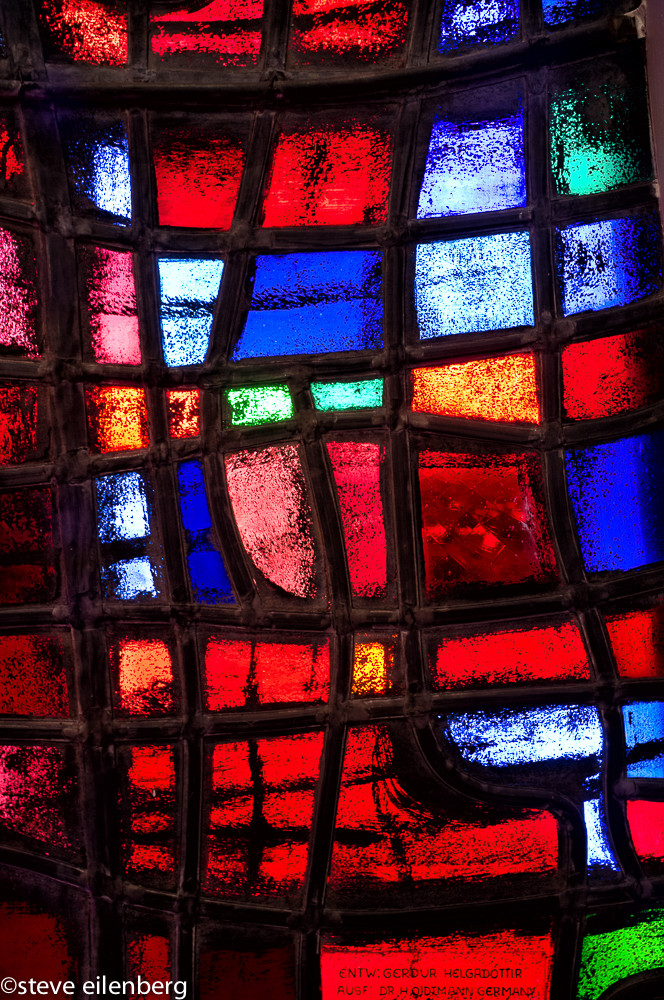
The church has a distinctive silhouette and is the symbol of the town of Kopavogur in which it resides.
Steve literally stumbled onto an underground sculpture trove. The mystery of these underground stone figures was finally solved for us 3 years later by Chris, our photography guide on our second trip. We were staying in a small cabin loaned by our exchanger’s mother in Husafell, in the shadow of the Langjokull glacier. After failing to find a cave on private property “10 minutes” down the road for a guided tour, we ended up at Sirtsellur, a lava cave available for self-guiding.
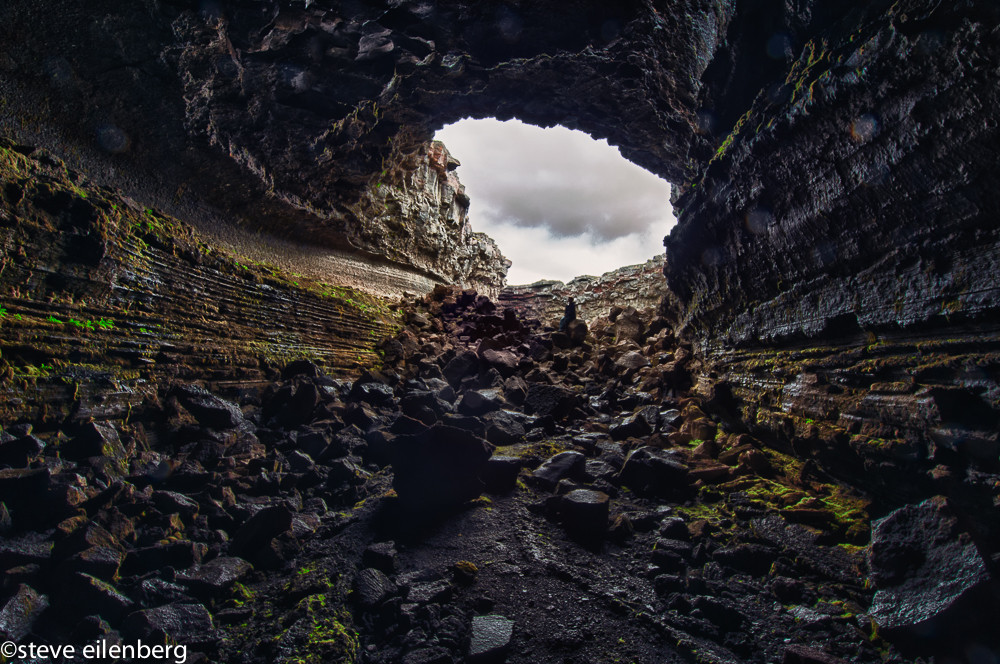
For scale, that tiny figure seated in the distance is me, dwarfed by this vast underground lava-formed cavern, Sirtsellur
It proved to be long, black, and damp, with treacherous footing, at least for me, although Steve managed it pretty nimbly. Each step seemed a potential, sometimes likely, ankle breaker, but thankfully no major injuries were sustained.
Once in, there were several sections which opened to the surface, where we could see out and even converse with other tourists viewing the cave from the rim. At one such opening, I seriously contemplated climbing a pyramidal pile of stones which seemed to nearly make the rim, and thought about asking one of the on-looking tourists if they would mind giving me a hand up if I were to climb out there. They indicated the parking area was but 300 meters on, so we continued on. Later, when I passed this opening hiking back to get the car, I saw that the pile of stones I had eyed with such longing was woefully short by feet of reaching the rim. When I reunited with Steve, he babbled on about trolls and flashlighting figures and heads in the final section of the cave. 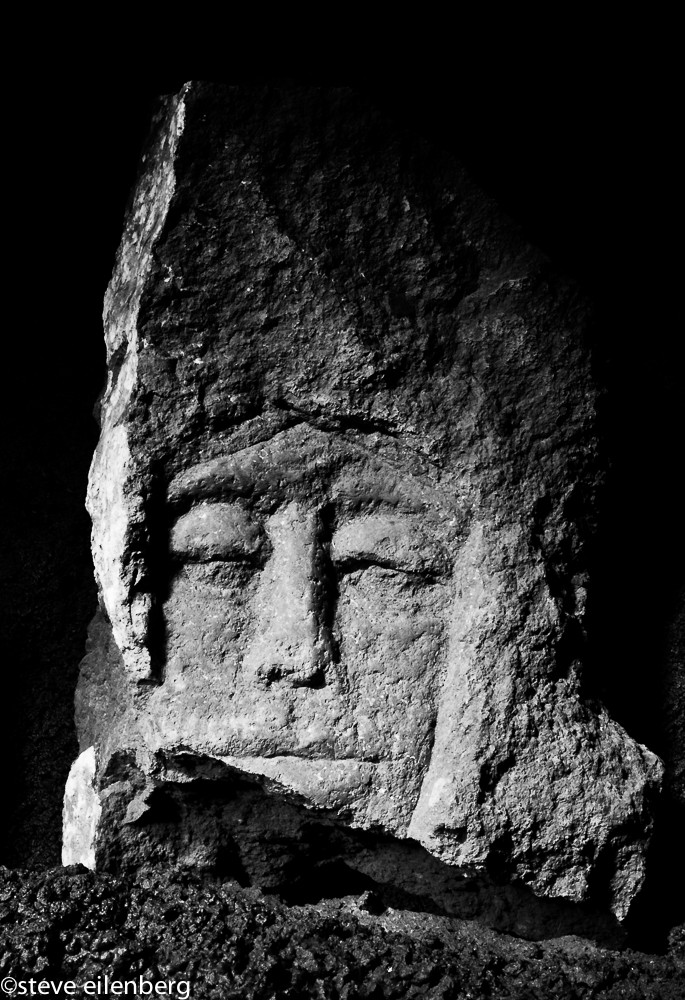 That is, I thought he was dehydrated and babbling, until he later downloaded proof of his underground sculptural finds. Three years later, recounting this story to Chris, he said: “Oh, that’s Páll Gu∂mundsson, the sculptor. He lives in Husafell. My girlfriend is friends with him.” He also is a musician who performs with the Icelandic band Sigur Rós with a unique xylophone-like instrument made of stones called the Steinharpa. The stones are from the area where he lives and each is an idiophone, naturally tuned to certain notes.
That is, I thought he was dehydrated and babbling, until he later downloaded proof of his underground sculptural finds. Three years later, recounting this story to Chris, he said: “Oh, that’s Páll Gu∂mundsson, the sculptor. He lives in Husafell. My girlfriend is friends with him.” He also is a musician who performs with the Icelandic band Sigur Rós with a unique xylophone-like instrument made of stones called the Steinharpa. The stones are from the area where he lives and each is an idiophone, naturally tuned to certain notes.
Small country, huh? But remarkably rich in inspiration and creativity. We certainly found the landscape inspiring, the subject of an eventual post.
-Marie

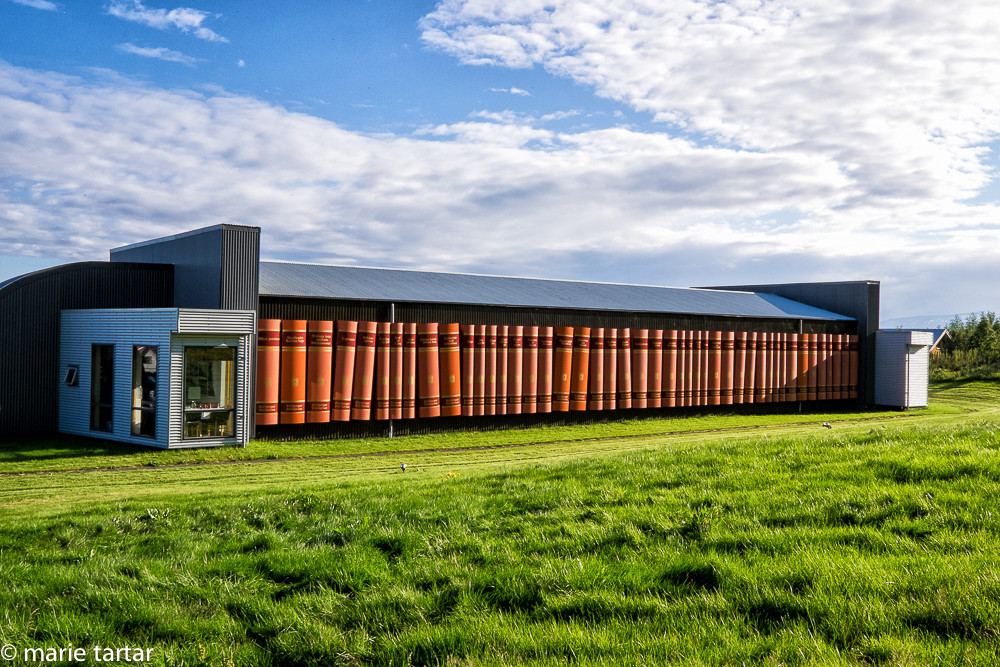
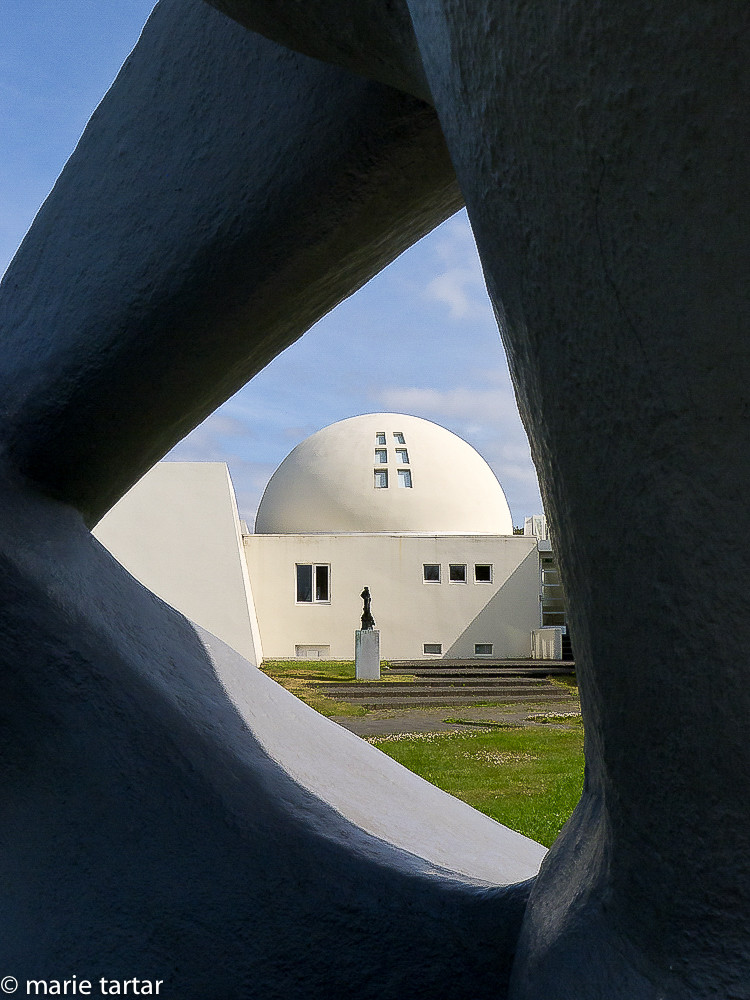

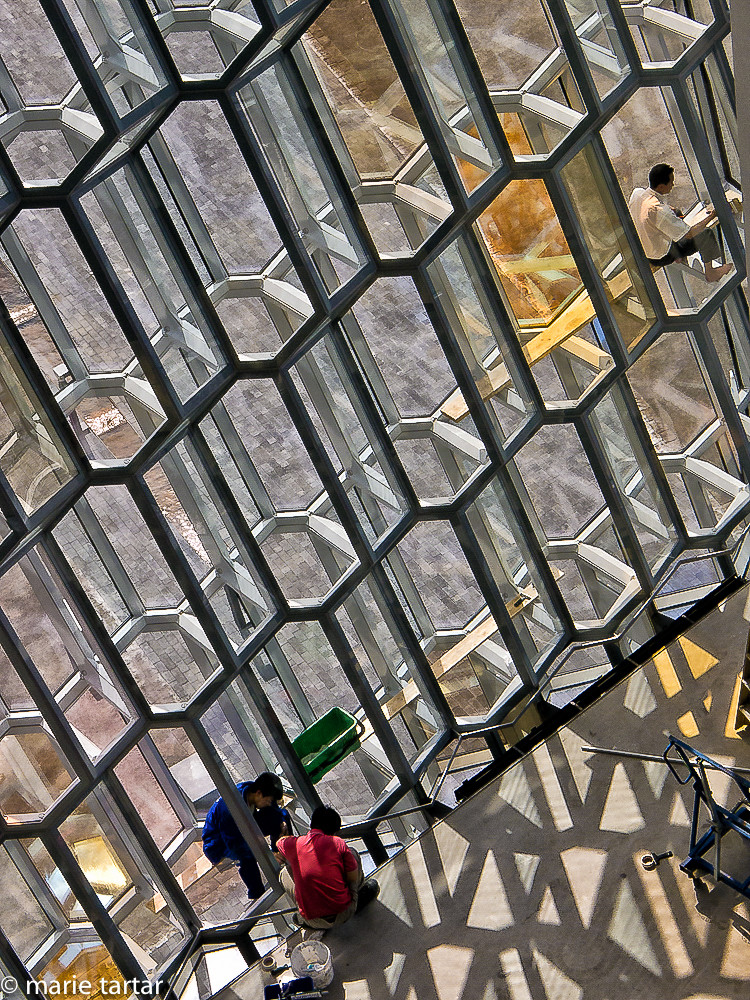




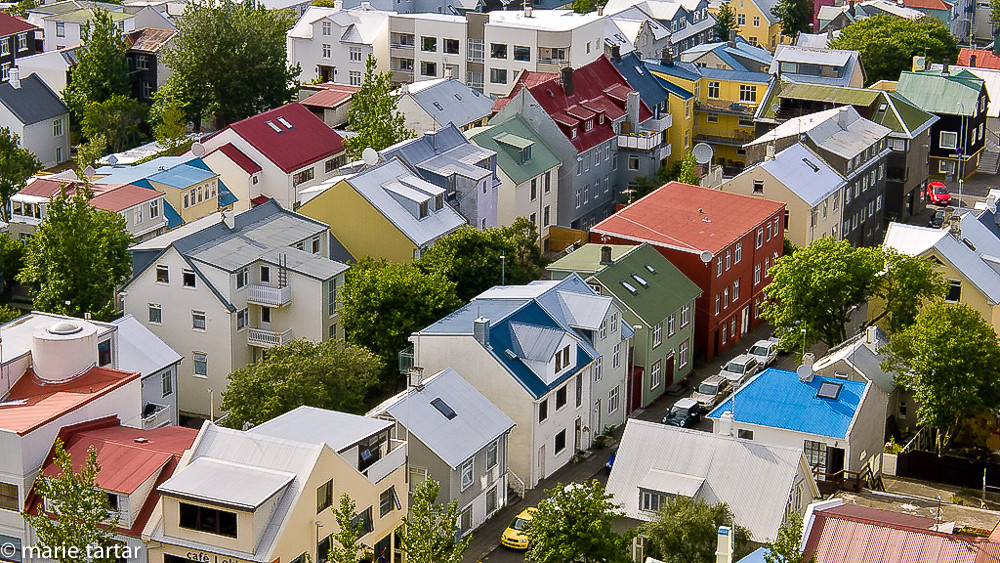
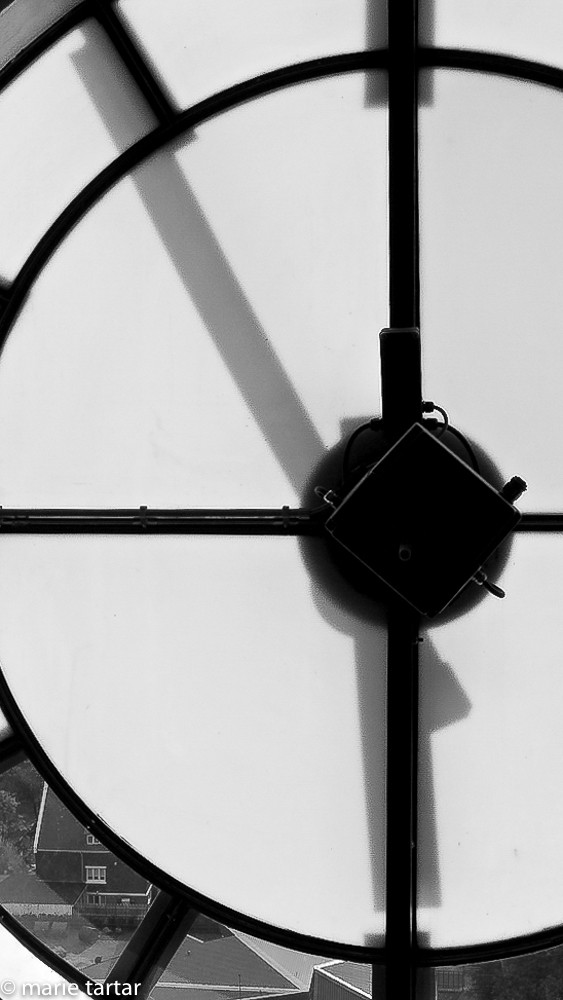
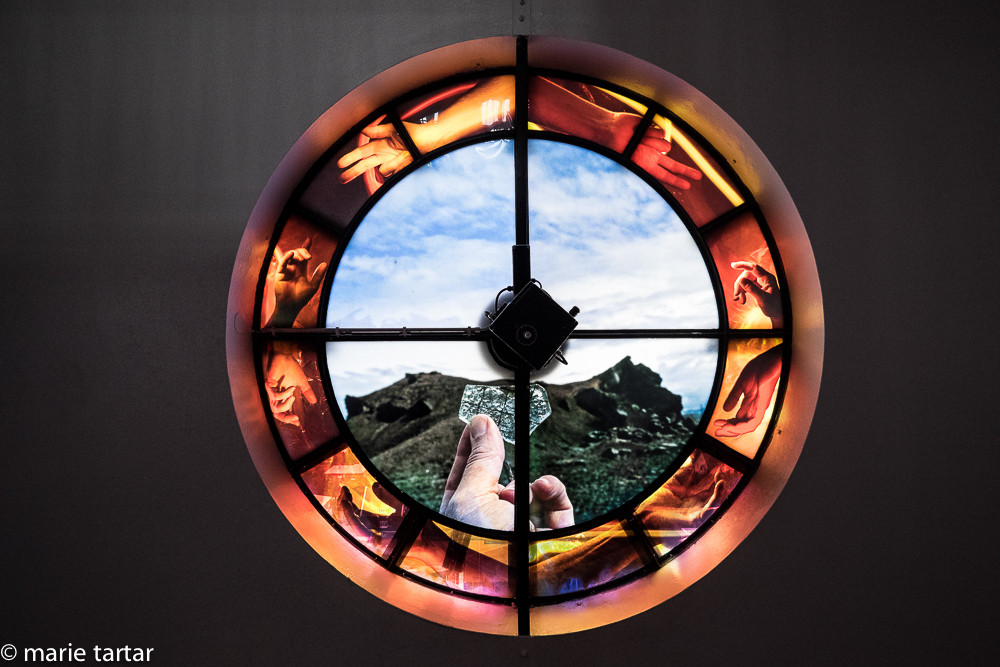




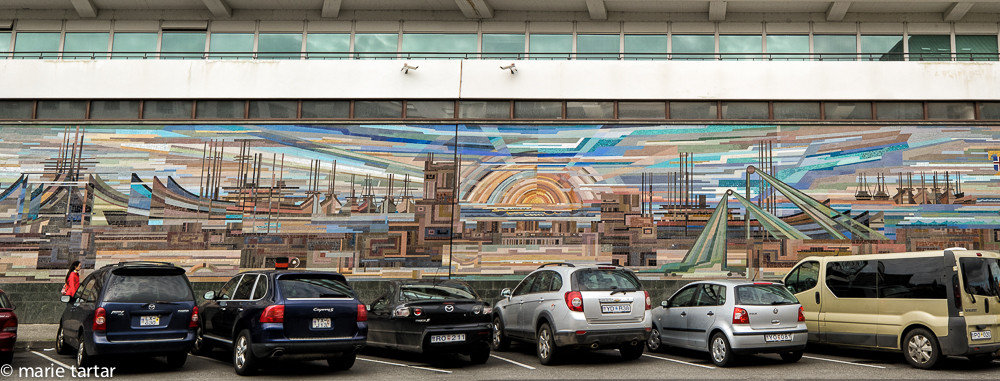
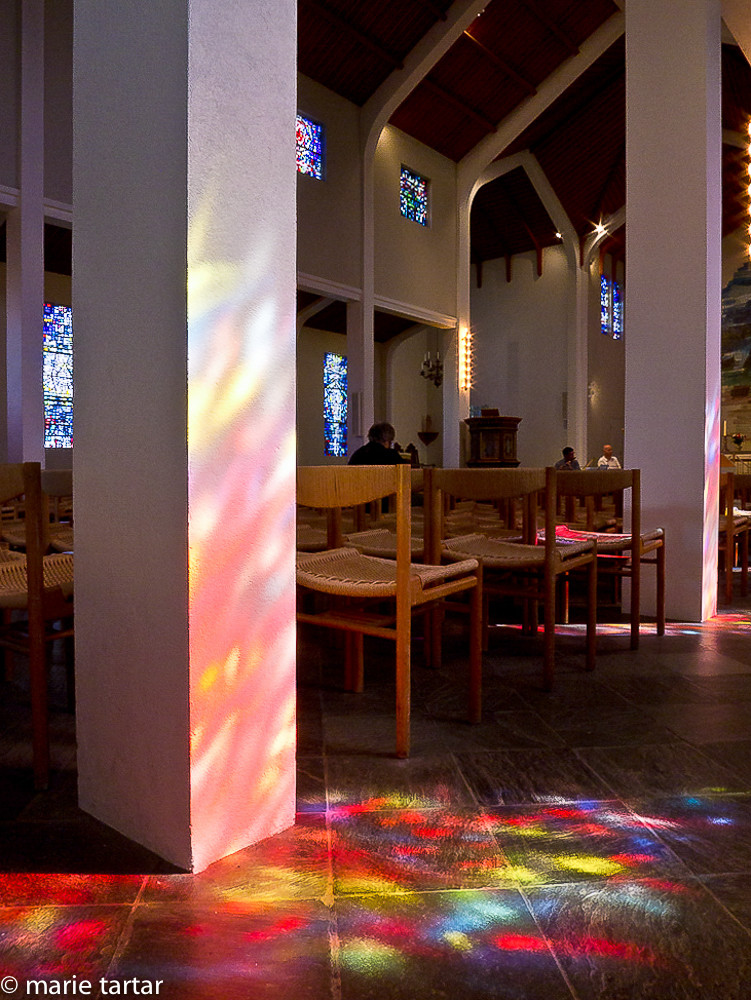
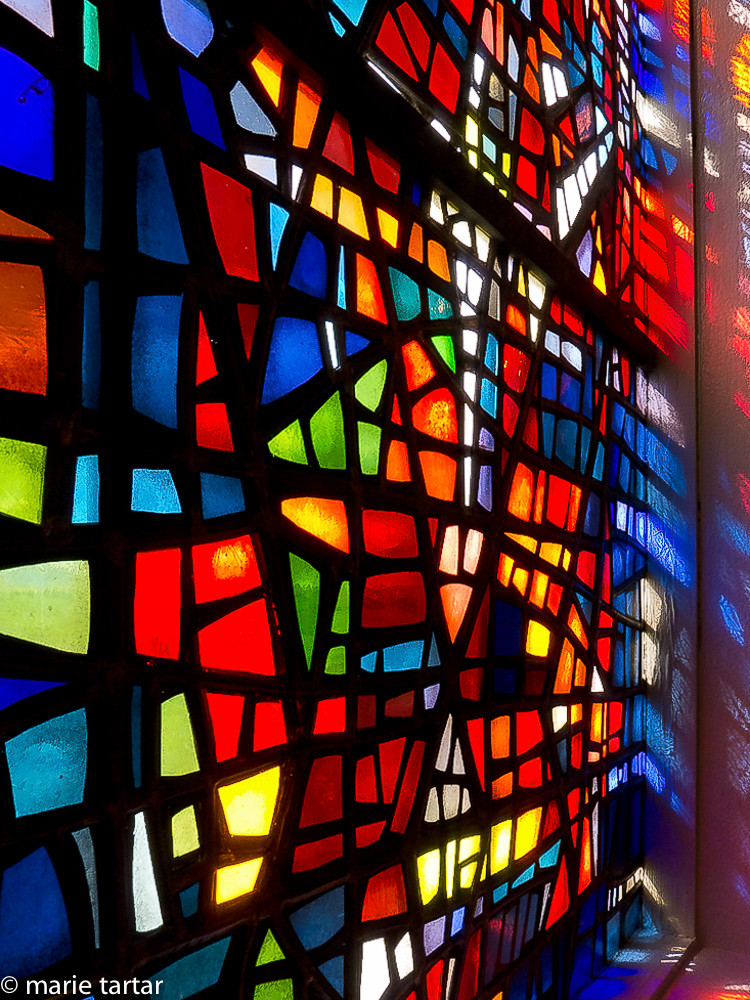

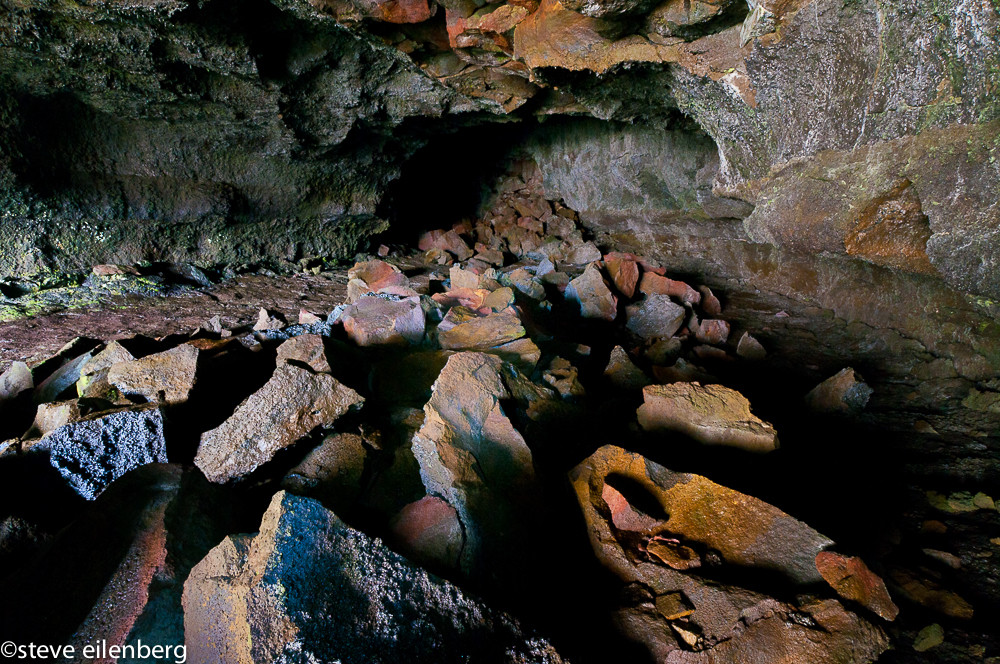
Babble? Do I babble? I didn’t know I babbled! Aside from this glaring inaccuracy, nice blog post.
I meant like a babbling brook. It seemed logical, you’d been in a dark and confined environment, then suddenly emerge spouting about trolls underground. What was I to think?!
Fabulous images and a wonderful read as always.
I am babbling mentally! What a travel log. I am now planning when we can go and how long to stay so you two can visit us to show us around. Every picture and text a readers delight. Thank you.
Absolutely beautiful…
Magnificent pictures—but great subjects, as well. David and our grandson loved the horses, the water, and the outdoor activities, but they missed a great deal. Perhaps a grandparents’ trip one of these days.
Magnificent pictures—and wonderful subjects. David and our grandson spent about three weeks in Iceland several years ago. They loved the outdoors, the water, and the horses, but missed a great deal. Maybe it’s time for a grandparent trip.
Thanks Ann, we also feel like we will need to find our way back there, perhaps in winter! Marie